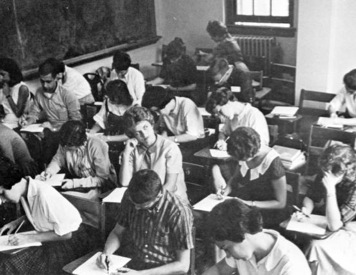Teaching Philosophy


History did not occur in a vacuum, it was impacted by society. Likewise, society sits upon the foundation of historical events. My teaching philosophy embraces the view that the two disciplines need not be divided. I feel my training in each only enhances my teaching in both. Indeed, an interdisciplinary approach to teaching history and sociology serves to enrich understanding of why key historical events occurred and how society developed and changed as a response to those events. To borrow from Andrew Abbott, “history limits generalization by emphasizing changing causal universes, while sociology provides the causal arguments.”2
Teaching Philosophy
While researching for my MA thesis, I engaged in fieldwork with the Roma in the Czech Republic. During this time, the establishment of an industrial pig farm on the grounds of a World War II concentration camp for Roma, near the town of Lety, created tremendous controversy. The government argued they did not have the money to buy the farm and establish a proper memorial. The newspapers quoted groups who blatantly denied the entirety of the Romani Holocaust and claimed the Roma who died in Lety were merely criminals – most died of typhus, they argued, and brought it upon themselves because they were dirty. I attended the memorial ceremony for the Roma who lost their lives in the camp. Nauseous from the stench of the pig farm, we laid wreaths on the mass graves. Holocaust survivor Karel Holomek, an academic and Romani activist, addressed the meager crowd. “It is not a question of money,” he argued. “It is a question of memory.” I recalled Cicero’s argument to the Roman senate when trying to convince them to erect a bronze statue in honor of his late friend Servius Sulpicius Rufus, “vita enim mortuorum in memoria vivorum est posita.” The life of the dead is placed in the memory of the living. I decided then, through teaching, I would honor the memory of the dead even as their bones rested, forgotten under a pig farm in the Czech Republic.
I began my teaching career in the nonprofit world. For fifteen years, I taught grant writing and management to international nongovernment organizations through an online module I developed for the nonprofit organization where I worked. I also taught grant writing and business English on-site in India, Peru, and the Czech Republic. Teaching non-native English speakers presented unique challenges. I had to learn to explain complex concepts using direct language and to supplement my lessons with visual presentations that helped illustrate important points. I learned to develop creative ways to involve students in classroom discussion in an environment where learning cultures center on listening, not participating. I noted my students’ struggles with the English language coupled with their learning experiences required a teaching style that encouraged self-efficacy. In order to increase self-efficacy among my students, I developed a habit of soliciting feedback during lectures by integrating regular ungraded quizzes and interactive questioning, instead of relying on testing. I noted an immediate improvement in my students’ course participation and assessment. Improving self-efficacy has since become a primary component of my teaching methodology.
As an engaged researcher of social injustice, I bring my research to the classroom. Threads of inequality and oppression stitch together the content of my courses. I aim to task students with reading beyond the texts to locate and question social constructs such as race, gender, sexuality, and stereotypes. This approach has the capacity to trouble the worldviews of students and challenge their comfort zones. However, challenge is encouragement to step outside of a comfort zone in order to achieve a new level of competence. The overarching goal is to guide an empathetic method of historical analysis that is connected to the contemporary world. To put my goal into practice, I design weekly discussion questions that lead students to find themes of power and inequality and consider not only how they shaped historical events, but also how they influenced the present. By constructing conditions for engaged conversation in a collaborative “safe” space, students have opportunities to discover different ways of thinking and to analytically defend their views.
The study of history is more than an attempt to understand what happened in the past, but why. To facilitate the “why” of history, my course topics integrate perspectives from various disciplines including history, sociology, political science, anthropology, and literature. Building bridges across disciplines makes students well versed, better able to collaborate with peers, and enables a more thorough understanding of issues and events. For example, in a course on the Holocaust, I take time to discuss the social conditions that contributed genocidal conditions in societies, the psychology of the bystander effect, and how anthropological literature influenced persecution of minority groups.
To facilitate active learning and to reach students with different learning styles, I make an effort to diversify the classroom experience by integrating a variety of sources: images, film, music, and primary documents. I make extensive use of personal primary sources such as diaries, photographs, and letters. Working with personal primary sources not only promotes critical thinking, but also captures students’ imaginations and helps them to better understand the multifaceted construction of history. I encourage students to choose their own research topics and work through drafts collaboratively. Self-designed research projects motivate students to explore and write about issues that interest them while instilling a sense of ownership in their research.
I teach to engage and to inspire. I endeavor to engage students in conversation with history and how it informs the world in which they live. Through enthusiasm and passion, I strive to inspire every student in my class to become a historian. Realistically, I understand some students choose different paths. Regardless of their academic direction, my goal is that they leave my classroom with the tools to succeed in any profession: the ability to read and think critically, to write analytically and persuasively, and to communicate effectively and openly.
___________________________________
Kolb, D. 1984. Experiential Learning. Upper Saddle River, NJ: Prentice-Hall.
Abbott, Andrew. 1991. History and Sociology: The Lost Synthesis. Social Science History 15, no. 2: 201-238.
Berger, Peter L. 1963. Invitation to Sociology; a humanistic perspective. Garden City, N.Y.: Doubleday.
Photo Credit: FSU students taking examination. 1961. RC01444. State Archives of Florida, Florida Memory.
Learning is a process, not an outcome; learning comes from experience; learning requires resolution of dialectically opposed demands; learning is holistic and integrative; learning requires interplay between a person and an environment; and learning results in knowledge creation.1




